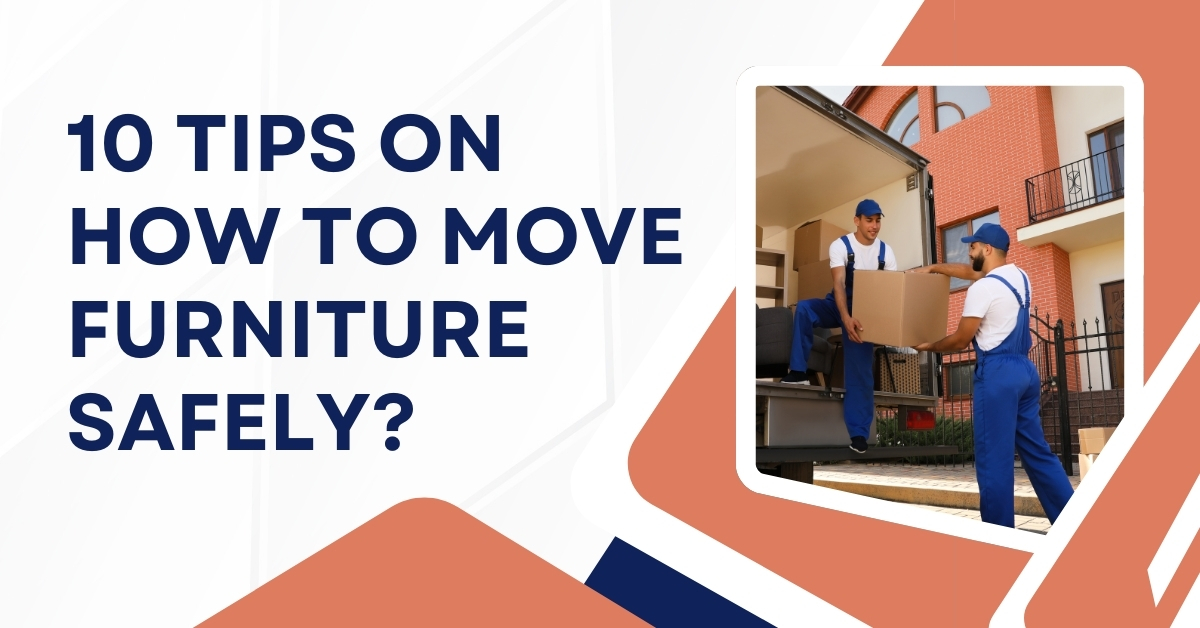Currently Empty: $0.00
10 Tips on How To Move Furniture Safely?
 Moving furniture is often one of the most challenging parts of relocating to a new home. Whether you’re moving across town or just rearranging your living space, the process requires careful planning and the right techniques to ensure that your belongings stay intact and everyone involved stays safe. By understanding the importance of moving furniture safely and following some essential guidelines, you can make the process smoother and avoid unnecessary injuries or damages.
Moving furniture is often one of the most challenging parts of relocating to a new home. Whether you’re moving across town or just rearranging your living space, the process requires careful planning and the right techniques to ensure that your belongings stay intact and everyone involved stays safe. By understanding the importance of moving furniture safely and following some essential guidelines, you can make the process smoother and avoid unnecessary injuries or damages.
How to Shift Your Furniture Without Damaging It?
1. Create a Detailed Furniture Moving Plan
Before you even start lifting or moving anything, take the time to create a comprehensive plan. This plan should include identifying which furniture pieces need to be moved, measuring doorways and hallways to ensure everything can fit, and deciding the order in which items should be moved. A well-thought-out plan helps you avoid unexpected obstacles and reduces the risk of accidents.
2. Disassemble Furniture When Possible
If your furniture can be disassembled, take the time to do so. Removing legs, cushions, or other detachable parts makes larger items more manageable and reduces the risk of damage during the move. Label each part and keep screws and small pieces in labeled bags to make reassembly easier. Disassembling also helps prevent scratches or dents that can occur when moving bulky items through narrow spaces.
3. Use Proper Furniture Moving Tools and Materials
Investing in the right moving equipment can make a significant difference in both safety and efficiency. Here are a few essential tools to consider:
Furniture Sliders
Furniture sliders are small discs that you place under the legs or corners of heavy furniture. They make it easy to glide furniture across floors, preventing scratches and minimizing the effort required to move bulky items.
Lifting Straps
Lifting straps are designed to help distribute the weight of heavy furniture more evenly between your shoulders and arms, allowing you to lift and carry large items more safely. These straps can be adjusted to fit different furniture sizes and are especially useful for moving items like mattresses or large tables.
Moving Dolly
A moving dolly is a must-have for transporting heavy furniture with minimal effort. It helps distribute the weight evenly and allows you to move items without lifting them completely off the ground, reducing strain on your body.
4. Practice Safe Lifting Techniques
Knowing how to lift heavy objects correctly is crucial for preventing injuries. Always lift with your legs, not your back. Bend your knees and keep your back straight as you lift, holding the object close to your body. Avoid twisting your torso while carrying heavy items, and if something feels too heavy or awkward to lift alone, ask for help.
5. Wear Appropriate Clothing and Footwear
What you wear on moving day can impact your safety. Opt for comfortable, close-fitting clothing that won’t get caught on furniture or moving equipment. Sturdy, non-slip shoes with good support are essential to protect your feet and provide stability while lifting and moving heavy items. Avoid wearing open-toed shoes or anything that might cause you to trip.
6. Prioritize Safety While Loading the Furniture
When loading furniture, safety should be your top priority. Start by clearing the path to the moving truck to avoid tripping over obstacles. Use a dolly or furniture sliders to minimize the physical effort needed to lift heavy items. If you’re lifting furniture manually, remember to bend at your knees and lift with your legs, not your back, to prevent injuries. Wearing sturdy, non-slip shoes and close-fitting clothing will help you maintain your balance and reduce the risk of accidents.
7. Navigating Stairs and Tight Spaces
Moving furniture up or down stairs or through tight spaces can be particularly challenging. To make it easier, measure your furniture and the spaces you need to navigate through before you start. If a piece seems too large to fit through a doorway or around a corner, consider disassembling it further or adjusting the angle at which you move it. For stairs, use lifting straps or a dolly to help control the weight and balance of the item as you move it up or down.
8. Take Regular Breaks and Stay Hydrated
Moving is physically demanding, and it’s easy to overexert yourself. To prevent fatigue and reduce the risk of injury, take regular breaks during the moving process. Stay hydrated by drinking plenty of water, especially if you’re moving on a hot day. Listen to your body—if you feel tired or sore, take a moment to rest before continuing.
9. Consider Hiring Professional Movers
While it’s possible to move furniture on your own, hiring professional movers can be a wise investment, especially for large or delicate items. Professional movers have the experience, equipment, and techniques needed to move furniture efficiently. They can also save you time and reduce the physical strain of moving, allowing you to focus on other aspects of your move.
10. Post-Move Checklist: Ensuring Everything Is in Order
Once your furniture is safely moved into your new space, take the time to inspect each piece for any damage that may have occurred during the move. Reassemble any disassembled items, and make sure everything is placed where you want it. This is also a good time to double-check that all screws, bolts, and other small parts are accounted for. If you hired professional movers, review your inventory list to ensure everything has been delivered and is in good condition.
How to Handle Specialty Furniture?
Specialty furniture, such as antiques, pianos, or items with delicate finishes, requires extra care during a move. For these pieces, consider the following tips:
- Antiques: Wrap each piece in furniture blankets or bubble wrap to protect it from scratches or damage. If possible, disassemble the item to make it easier to move.
- Pianos: Moving a piano requires specialized equipment and expertise. Consider hiring professional piano movers to ensure your instrument is handled with care.
- Delicate Finishes: Use soft blankets or padding to protect furniture with delicate finishes. Avoid using tape directly on the furniture, as it can leave residue or damage the surface.
Final Thoughts
Moving furniture safely requires a combination of planning, the right equipment, and proper techniques. By following these tips, you can reduce the risk of injury and ensure your furniture arrives at its new location in good condition. Whether you’re handling the move yourself or working with professionals, such as furniture movers in Grand Prairie, TX, it’s crucial to take your time, ask for help when needed, and use the proper tools for the job. Moving may be a demanding task, but with the right approach, including considering professional movers for challenging items, you can make the process as smooth and safe as possible.
Common Questions About Moving Furniture
Q: How can I move large furniture through narrow doorways?
A: Measure both the furniture and the doorway to determine if the item can fit through without disassembly. If it’s too large, consider removing doors or disassembling the furniture. You may also need to adjust the angle at which you move the item to navigate it through tight spaces.
Q: What should I do if I can’t lift heavy furniture on my own?
A: Never attempt to lift heavy furniture alone. Always ask for help from friends, family, or professional movers. Use lifting straps or a moving dolly to make the process easier and safer.
Q: How can I protect my floors and walls while moving furniture?
A: Use furniture sliders under the legs of heavy furniture to prevent scratches on your floors. Place blankets or padding along walls and door frames to protect them from accidental bumps during the move.
Q: What are the most common injuries from moving furniture, and how can I avoid them?
A: The most common injuries include back strains, sprains, and cuts or bruises. To avoid these, always lift with your legs, use proper moving equipment, wear appropriate clothing and shoes, and take breaks to avoid overexertion.
Q: Should I hire professional movers for specialty furniture?
A: Yes, it’s often best to hire professional movers for specialty items like pianos, antiques, or furniture with delicate finishes. Professionals have the experience and tools necessary to move these items safely.





